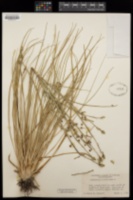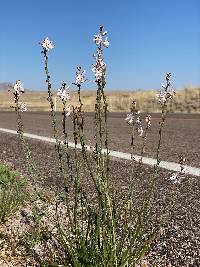|
|
 Plant - basal leaves California Botanic Garden Herbarium, Usage Rights: CC BY-NC (Attribution-Non-Commercial) |  Plant Sue Carnahan @http://swbiodiversity.org, Usage Rights: CC BY-NC (Attribution-Non-Commercial) | | | | |
|
Origin:
Introduced
Life Cycle:
Annual, biennial or perennial Similar Species: Asphodelus ayardii
General Desc:
Annual, biennial or perennial with hollow, upright, leafless stems; clumps of many grass-like leaves grow from the plant base. White to pale pink flowers with brown or reddish center stripes grow on spike-like clusters.
Identification notes: Herb, annual or perennial or biennial, from swollen rhizomes; leaves numerous, basal, blade narrow; stems hollow; sepals similar shapes, barely fused, prominently veined; stamens 6, filaments base expanded; style 1, weakly 3-branched; ovary 3-chambered.
Height:
To nearly 2-1/3 feet
Habitat Description: Found in dry, sandy and rocky places as well as pastures, open woodlands, rangelands, roadsides, railway lines, fields and waste places.
Plant Communities:
Desert Scrub, Interior Chaparral, Semidesert Grasslands, Pinyon Juniper Woodland, Disturbed Areas
Elevation: Below 4600 feet
Color:
White to pale pink
Shape:
Regular in elongated clusters
Tubular:
N
Flowering Period:
Mar - Jul
Description:
Each flower is about 3/4 inch across and has 6 white to pale pink tepals (sepals and petals). Each tepal has a brown or reddish stripe down its center. Up to 30 of these flowers are widely spaced along the upper parts of the branched flowering stem.
Leaf Color:
Dark green
Leaf Type:
Simple
Leaf Shape:
Narrow
Leaf Margin:
Smooth
Leaf Attachment:
Basal
Leaves Clasp:
N
Hairs:
No
Spines:
N
Leaf Description:
Leaves are grass-like, a bit fleshy, smooth, hollow and rounded or slightly flattened on their upper surface. Leaves grow to nearly 14 inches long and from 1/16 to 1/4 inch wide. Hollow stems are rigid, smooth and usually branched in their upper parts.
Fruit Color: Brown
Fruit Type: Capsule
Fruit Notes: Each fruit is a brown, rounded capsule, 1/4 to 1/2 inch long, with a wrinkled surface (rugose) and divided into 3 segments (chambers) each containing 1 to 2 seeds. Fruits turn from greenish to reddish-brown to brown as they mature.
Seed Notes: The seeds remain viable for several years and are easily transported in trade, on vehicles and by animals. Each seed is triangular, dark brown or black, 1/8 to 1/4 inch long and marked by deep depressions (pits) making for a rough surface texture.
|
|